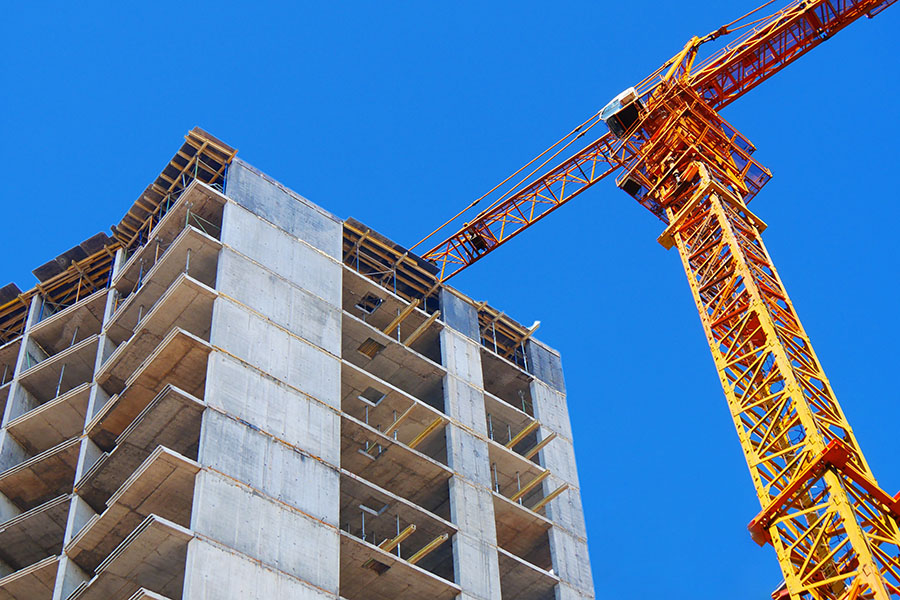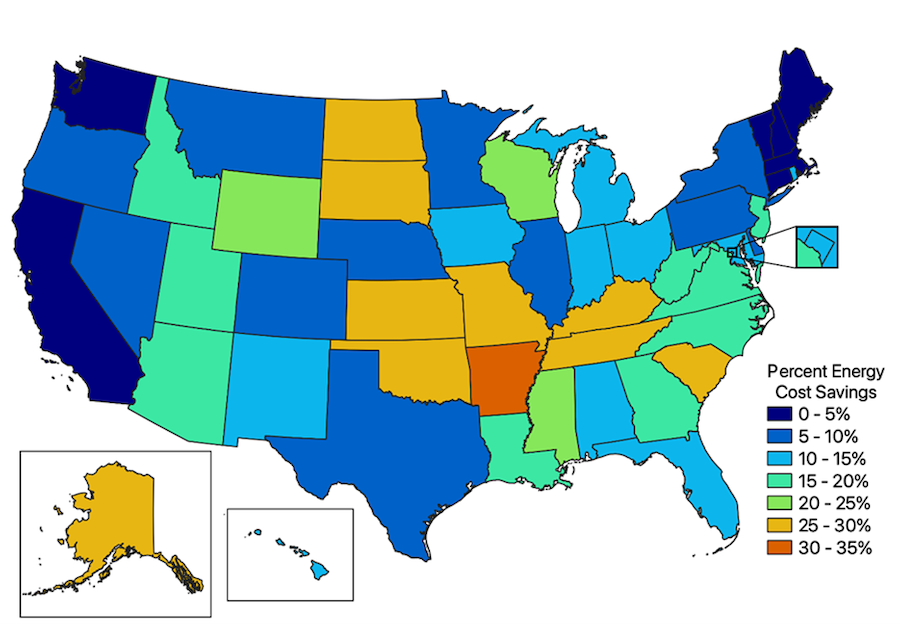Jan 16, 2023
Study Identifies States with Best Opportunities to Cut Costs and Emissions by Updating Building Codes Using Federal Climate Funds
Louisiana, North Carolina, Colorado, North Dakota, Minnesota, Virginia, Wyoming, Arkansas, South Carolina, and Tennessee are the 10 states most primed to benefit from updating outdated building codes.

States could cut energy use in new buildings by as much as a third—significantly reducing utility bills and greenhouse gas emissions—by updating building energy codes with the help of new federal funds. New analysis from the American Council for an Energy-Efficient Economy (ACEEE) identifies the states best positioned to take advantage of the federal funding by analyzing several factors in each state, including energy savings achievable for new buildings under a stronger code, the pace of new building construction, and greenhouse gas (GHG) emissions from buildings. The new analysis allowed ACEEE to evaluate how stronger codes could help states meet their climate targets.
The study comes as unprecedented federal resources become available to states to update building codes. Last month, the Department of Energy announced the first $45 million of a five-year, $225 million grant program—established by the 2021 bipartisan infrastructure law—to help states and localities implement updated building energy codes. The Inflation Reduction Act will provide another $1 billion to help states and local jurisdictions adopt and implement stronger codes.
Building energy codes set requirements for building construction, such as for insulation, windows, or heating systems. Stronger codes reduce energy use in new buildings and thus cut utility costs and GHG emissions from burning fuels in the buildings and from power plants that provide the buildings with electricity.
“States with out-of-date building energy codes miss out on a cost-effective pathway to reduce energy use and greenhouse gas emissions, leaving residents with higher utility bills,” said Michael Waite, senior manager in ACEEE’S buildings program and author of the study. “States and cities have an unprecedented opportunity to update their codes thanks to federal assistance. The jurisdictions that would see the greatest benefits should not pass up this opportunity.”
The 10 states most primed to benefit from updating outdated building energy codes are listed below:
- Louisiana could reduce energy use 20% in new residential buildings and 32% in new commercial buildings if it implements the latest building codes.
- North Carolina is among the top 20 states for potential residential and commercial energy savings and top 10 states for building construction, with about average building emissions, providing an opportunity for lower emissions with more efficient new buildings.
- Colorado, where local jurisdictions set building codes, has fairly high building emissions and the fifth-most construction activity among states, meaning it would greatly benefit from local jurisdictions updating building energy codes.
- North Dakota has the highest average building emissions of any state, giving the state an opportunity for progress with widespread adoption of new energy codes by local jurisdictions.
- Minnesota has roughly median building emissions, significant construction activity, and ambitious climate targets, so advancing its energy codes would have meaningful impact.
- Virginia needs to see the most emissions reduction of any state to meet 2030 climate targets, so strengthened energy codes should be part of a comprehensive climate strategy.
- Wyoming, where localities set building codes, has very high building GHG emissions, so it would benefit from improving building energy efficiency (in addition to reducing fossil fuel generation in its electric grid).
- Arkansas could see 30% energy cost savings in new residential buildings—more than any other state—and 33% savings in new commercial buildings if it enacts up-to-date building codes.
- South Carolina is fourth among states in per capita construction activity and uses old versions of model energy codes, meaning updated codes would provide major energy savings.
- Tennessee has significant building construction, and the state would see the second-highest cost savings from updating its residential energy code, as well as substantial savings from commercial building code updates.
The full ranking and details for all states are included in the policy brief. In addition to identifying states that would benefit most from federal funding for updated building energy codes, the analysis shows the diversity of factors that affect the energy, monetary, and GHG savings of higher efficiency building codes. “Ultimately, the benefits depend on how successfully advanced codes are implemented in states and jurisdictions,” Waite said.
ACEEE’s analysis found 16 states could cut energy costs in new homes by at least 20% and 14 states could decrease energy costs 20% in new commercial buildings by adopting the most recent national building energy codes. The research found that residents and businesses in Arkansas, Oklahoma, Tennessee, Kentucky, North Dakota, Missouri, South Carolina, and South Dakota would see the greatest cost savings from updating residential building energy codes. For commercial buildings, Louisiana, Oklahoma, Arkansas, South Carolina, Missouri, and South Dakota residents and businesses would save the most money from adopting new energy codes.

Sun Belt states from the Southeast to the Southwest have among the greatest level of new building construction, meaning those states would see substantial energy, monetary, and GHG savings from updated building codes. Outside the Sun Belt, Colorado, Idaho, South Dakota, and Utah have widespread construction but out-of-date building codes, giving them the opportunity to make significant progress.
GHG emissions from buildings vary widely across the country. States with higher emissions often rely largely on coal for power generation and have significant heating needs, meaning that improving outdated building codes would have the greatest benefit as part of an overall climate strategy.
Most states that have set GHG reduction targets are not on track to meet them, with only Illinois and Maine on a trajectory to meet 2030 climate goals. Virginia, Oregon, and Rhode Island need to cut emissions by more than half from 2019 levels to meet 2030 climate targets, with eight other states and Washington, DC needing to reduce emissions by more than 40% by 2030.
Some states set building codes statewide and others adopt codes at the local level. The federal funding for code updates is designed to go through states, meaning that in states where localities set building codes, state and local governments will need to partner to ensure they are able to benefit from the federal funding.
This article originally appeared on ACEEE’s blog and is reprinted with permission.





